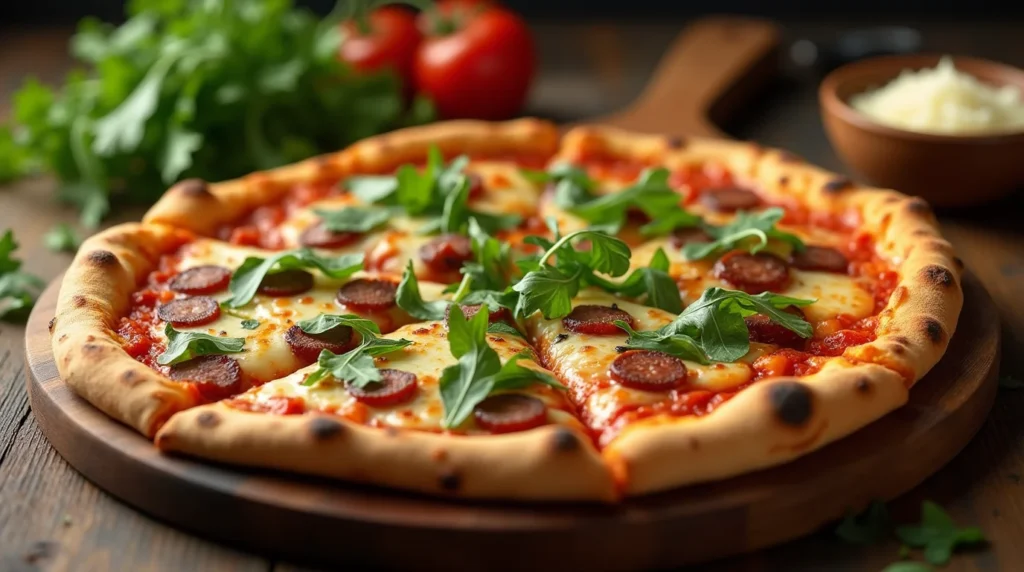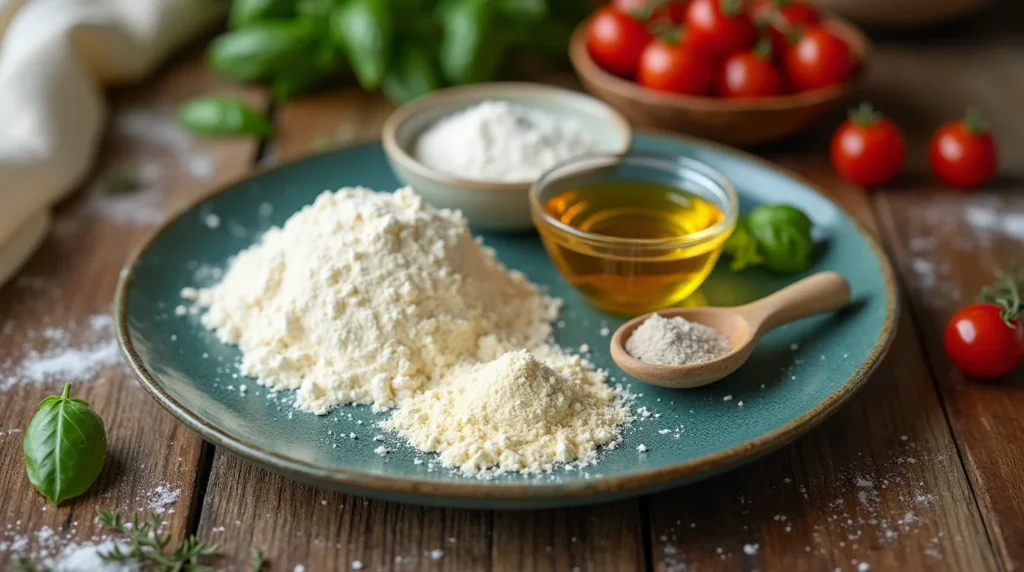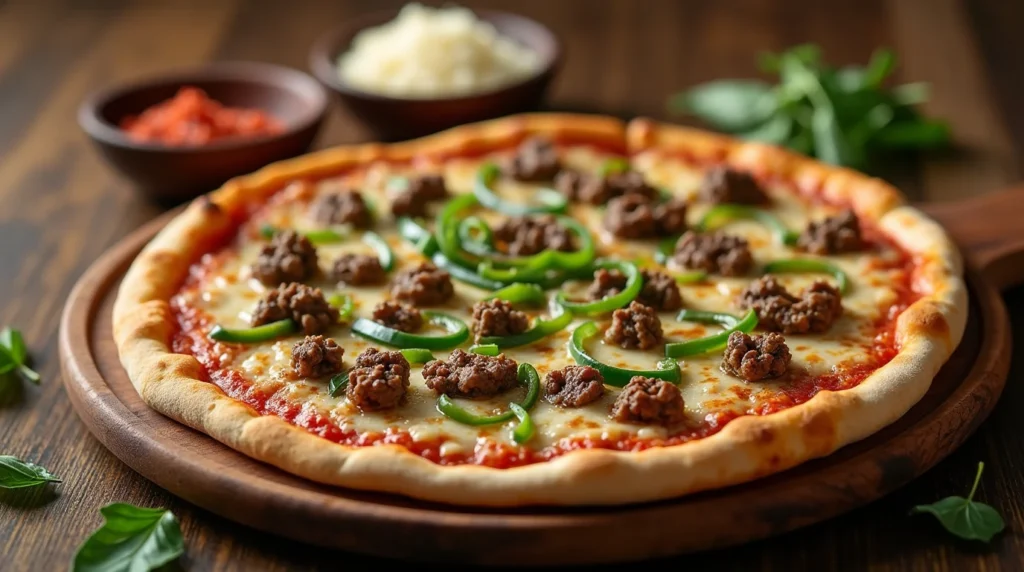
Authentic Italian Pizza Dough Recipe | Simple Steps
Share this recipe
I love pizza, especially the real Italian kind. The smell of fresh dough, the mix of flavors, and making each slice a work of art. It’s more than just food. Here, I’ll teach you how to make the best Italian pizza dough at home.
This italian pizza dough recipe comes from my love for Neapolitan pizza. With a few simple ingredients and old-school techniques, you’ll make a crust that’s crispy outside and chewy inside. It’s perfect for both pizza lovers and new cooks, bringing Italy to your table with every slice.
Italian Pizza Dough Recipe: Complete Ingredients Guide
Ingredients per Serving:
- 2 1/4 cups (281g) all-purpose flour
- 1 teaspoon (5g) salt
- 1 teaspoon (5g) active dry yeast
- 1 1/4 cups (296ml) warm water (between 105-115°F/40-46°C)
- 1 tablespoon (15ml) olive oil
Serving Size: One 12-inch pizza
Preparation Time: 15 minutes
Cooking Time: 12-15 minutes
Total Time: 27-30 minutes
Nutritional Facts (per serving):
- Calories: 275
- Protein: 8g
- Carbs: 48g
- Fats: 4g
- Fiber: 2g
- Sodium: 320mg
- Sugar: 0g
Key Takeaways
- This authentic italian pizza dough recipe makes a classic Neapolitan crust that’s crispy and chewy.
- The ingredients are simple: flour, salt, yeast, warm water, and olive oil.
- It’s quick to make, ready in under 30 minutes, perfect for any day.
- Each serving is balanced, making it a healthy choice for your pizza.
- Follow this guide to make neapolitan pizza dough like a pro at home.
Understanding the Art of Traditional Italian Pizza Making
Exploring the history of Neapolitan pizza, we learn about the detailed techniques and traditions. These have been shared by generations of Italian pizza makers. From Naples’ vibrant city to the art of making perfect neapolitan pizza dough, it’s a journey worth taking.
The History Behind Neapolitan Pizza
The story of Neapolitan pizza starts in the 18th century. Working-class people in Naples made flatbreads with fresh ingredients. This simple dish became the famous Neapolitan pizza we love today.
Wood-fired ovens, quality local ingredients, and traditional methods have made this pizza a classic.
Why Technique Matters in Italian Pizza Making
Making the perfect neapolitan or wood-fired pizza dough is an art. It’s not just about following a recipe. It’s about the technique and detail.
From the right amount of water to kneading and fermentation, each step is important. It helps create the light, airy crust and balanced flavors of authentic Italian pizza.
“The key to crafting the perfect pizza lies in mastering traditional techniques, honed and handed down through generations of Italian pizza artisans.”
Learning about the history and technique of Italian pizza making can help you make your own delicious pizzas. Bring the flavors of Italy straight into your kitchen.
Essential Equipment for Perfect Pizza Dough
To make authentic Italian pizza dough at home, you need the right tools. From measuring to storing, having the right equipment is key. It helps you get the perfect dough texture and hydration levels. Let’s look at the must-have items for making pizza.
The Essentials
- Kitchen Scale: Accurate measurements of pizza dough ingredients are vital for the right pizza dough hydration levels. A digital kitchen scale ensures the perfect ratios.
- Mixing Bowls: Get high-quality mixing bowls, like stainless steel or glass, for easy dough mixing.
- Dough Scraper: This tool is great for kneading, portioning, and transferring dough without damaging it.
- Airtight Storage Containers: Keeping dough fresh and moist is crucial. Use containers with tight lids to prevent drying out.
“The secret to perfect pizza dough lies in precise measurements and careful handling of the ingredients.”
With these essential tools, you’ll be on your way to making perfect homemade Italian pizza dough. You’ll get consistent results and delicious pizzas every time.

Italian Pizza Dough Recipe: Complete Ingredients Guide
Making the perfect Italian pizza dough is all about knowing the right ingredients. From flour to water and yeast, each part is key to a great Neapolitan crust. Let’s explore the ingredients needed for an Italian pizza dough recipe.
Types of Flour for Pizza Dough
The base of your pizza dough is the flour. Italian pizza makers often use “00” flour for its light, airy texture. This flour has low protein, which is good for the dough’s texture. You can also mix “00” flour with bread flour for a firmer dough.
Water Temperature and Quality
The water’s temperature and quality are crucial. Use water that’s lukewarm, between 95-105°F (35-41°C). This helps the yeast work well. Also, using filtered or spring water can improve your crust’s taste and texture.
Yeast Selection and Usage
Italian pizza makers often use fresh or active dry yeast. The amount depends on how long you want the dough to rise. A good rule is to use 1-2 teaspoons of active dry yeast or 1-2 cubes of fresh yeast per 1 pound of flour. Make sure to bloom the yeast in warm water before adding it to the dough.

“The secret to a truly authentic Italian pizza lies in the simplicity and quality of the ingredients.”
Mastering the pizza dough ingredients takes practice. Experiment to find the perfect mix for you. With some effort, you’ll make pizza dough that rivals restaurant quality in your kitchen.
Mastering the Right Hydration Levels
Creating a true Neapolitan-style pizza dough starts with the right pizza dough hydration levels. The water-to-flour ratio is key. It affects the dough’s texture, how easy it is to shape, and its quality.
Neapolitan pizza dough usually has a high water content, between 60% to 70%. This high water level makes the crust soft, airy, and chewy. Getting the neapolitan pizza dough hydration just right can really improve your pizza-making skills.
- Understand the Impact of Hydration: More water in the dough means it’s easier to stretch and shape. This makes the dough more pliable and extensible.
- Calculate the Hydration Percentage: To find the hydration percentage, divide the water weight by the flour weight and multiply by 100. For example, with 200g of water and 300g of flour, the dough is 66.7% hydrated.
- Adjust Hydration for Different Pizza Styles: Neapolitan pizza loves high hydration, but other styles might need less. New York-style pizza, for instance, might do better with 55-60% hydration.
Remember, the perfect hydration level is not a one-size-fits-all solution. It’s crucial to experiment and find the right balance that works best for your pizza-making preferences and the style you’re aiming to achieve.

Mastering pizza dough hydration levels will help you make the perfect Neapolitan-style pizza crust. It will look great and taste amazing.
Step-by-Step Mixing Process
Making the perfect pizza dough is all about technique and precision. The first step, mixing, is key to a great crust. Let’s explore how to mix your ingredients perfectly.
Initial Mixing Technique
Start by mixing your pizza dough ingredients in a big bowl. Put flour in the bowl first and make a well. Then, add warm water and yeast.
Use a spoon or your hands to mix the flour into the liquid. Keep going until you get a shaggy dough.
Incorporating Ingredients Gradually
- After the dough comes together, it’s time to knead. Knead for 5-10 minutes, adding flour as needed to avoid sticking.
- While kneading, add salt and olive oil slowly. This helps the dough soak up flavors and get the right texture.
- Check the dough’s feel. Add flour or water to make it smooth, elastic, and slightly sticky.
Getting good at mixing and kneading is crucial for a great homemade pizza. With practice, you’ll make a perfect Italian-style crust.
“The key to great pizza dough lies in proper mixing and kneading. Take your time and let the dough develop that beautiful gluten structure.”
Professional Kneading Techniques
Kneading is key in making pizza dough. It builds the gluten and makes the dough soft and elastic, just like Neapolitan pizza. Learning to knead well is crucial for a great pizza crust.
Start by dividing the dough into smaller parts. This makes kneading easier and more comfortable. Place your hands on the dough, fingers spread, palms down. Push the dough away, then fold it back towards you. Keep doing this until you’ve covered the whole dough.
- Knead the dough for about 5-10 minutes, depending on its size. The dough should get smoother, more elastic, and less sticky as you knead.
- If the dough gets too sticky, add a bit of flour. But don’t add too much, or it will get tough.
- Avoid overworking the dough, as this can damage the gluten structure and result in a tough, dense crust.
“The key to perfect pizza dough kneading is to develop the gluten while maintaining a soft, pliable texture.”
Keep kneading until the dough has an even texture. This ensures it rises evenly and cooks beautifully. With practice, you’ll get the hang of kneading and make delicious Neapolitan-style pizza at home.
The Science of Dough Fermentation
Mastering the art of pizza dough fermentation is key to a perfect crust and flavor. This process turns simple ingredients into a complex, flavorful dough. Yeast and bacteria play a big role in this transformation. Knowing the science behind it can elevate your pizza-making skills.
Room Temperature vs. Cold Fermentation
The choice between room temperature and cold fermentation affects the final product. Room temperature fermentation is quicker, leading to a faster rise. However, it might make the dough taste yeasty or acidic.
Cold fermentation takes longer but offers a more complex taste. It brings out subtle sweetness and a chewy crust.
Signs of Proper Fermentation
Knowing when your dough is fermented right is crucial. Look for these signs:
- Significant increase in dough volume (usually doubling or tripling in size)
- Presence of small air bubbles throughout the dough
- A slight, yeasty aroma that is not overpowering
- A smooth, supple texture that is slightly tacky to the touch
By grasping the science of pizza dough fermentation and proofing pizza dough, you can enhance your homemade pizzas. This will bring an authentic Italian taste to your kitchen.
Proper Dough Ball Formation
Making the perfect pizza begins with learning to form dough balls. After the dough ferments, it’s time to shape it into tight balls. This step is key for getting the neapolitan pizza dough look and feel.

To shape dough balls well, follow these steps:
- Divide the Dough: Split the fermented dough into equal parts carefully, without deflating it.
- Pre-Shaping: Flour a clean area lightly and shape each part into a loose ball. Tuck the edges under to make the surface smooth.
- Resting: Let the pre-shaped dough balls rest for 15-20 minutes, covered. This relaxes the gluten, making stretching easier.
- Final Shaping: Hold each dough ball and use a circular motion to tighten the surface. This makes the ball smooth and even.
Handling the dough gently and avoiding overworking it is essential. This keeps the dough’s delicate structure intact. Your neapolitan pizza dough will then be ready for the next step.
“The secret to great pizza is in the dough – it all starts with the foundation.”
Stretching and Shaping Methods
Making the perfect pizza crust starts with stretching and shaping the dough. Some use a rolling pin, but the traditional Italian way is hand-stretching. This method keeps the dough airy and delicate, just like a Neapolitan-style pizza.

Hand Stretching vs. Rolling Pin
The rolling pin might seem quick and easy, but it can make the dough dense. Hand-stretching keeps the dough light and pliable. It’s perfect for a wood-fired oven. With practice, you can shape the dough into a perfect circle.

Common Shaping Mistakes to Avoid
One big mistake is overworking the dough, making it tough. Another is letting it rest too long, making it hard to shape. To get the right shape, work the dough gently and watch the resting time. This keeps it elastic and easy to shape.









